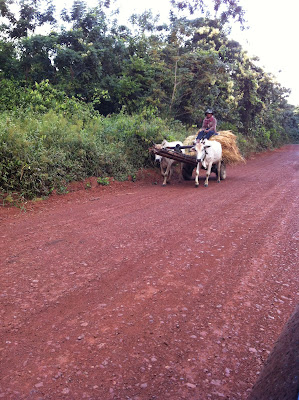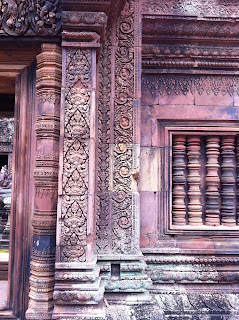I left Siem Reap in Cambodia last night at 11:15 and arrived in Seoul, Korea at 6:00 am this morning. I had 12 hours before my next flight to Vancouver so I signed up for a city tour of Seoul. We were in a nice 15-person van and visited the Cheonggyecheon Stream, a manmade stream down the centre of downtown Seoul. It is crossed by 27 bridges and has an artistic concrete walkway down both sides and city park along both river banks. It is meant to replicate the original stream that flowed through Seoul before the river flowing from the mountains was blocked.
We then visited Changdeok Palace, the best preserved of the five palaces of the Joseon Dynasty. This palace is listed as a UNESCO World Heritage Site and was originally built in the mid 1400's.
Our next stop was the Jogyesa Temple, the headquarters of the main sect of Korean Buddism
We had lunch of Korean food at a local restaurant and then had some time to browse the shops on Insadong Street. Apparently Insadong is a famous antique street but I had not heard of it before. It is primarily Korean souvenirs and I am souvenir shopped out so was not terribly impressed. However it was a good way to pass six hours even though I had only a couple hours sleep last night and could hardly keep my eyes open on the bus.
Korea is so different from Cambodia. Korea is new because Seoul was pretty much destroyed in 1950 when North Korea invaded so after the war everything was rebuilt. There are hundreds, if not thousands of huge apartment buildings. There are organized traffic patterns and traffic lights, neither of which is seen in Cambodia. However there are lots of traffic accidents in Seoul and hardly any in Siem Reap where various modes of transport are winding around each other but never stopping. It is a seemingly disorganized and scary free-for-all on Cambodian roads but in reality it is a ballet of thousands of very aware and alert drivers.
Thursday, 8 December 2011
SIEM REAP, December 8, 2011 Kompong Pluk & Floating Forest
 |
| Fisherman seen on the way to the village |
 |
| Pigs and chickens for future meals in the cage on the water. |
 |
| Woman washing clothes at the guest house we stopped to visit |
 |
| Kitchen of the guest house. Note the gaps in the floor down to the water and an open flame fire boiling the water. How safe is this? |
 |
| Women sorting a recent fish catch |
 |
| Tamara on our boat. They put down a rug for us but no locals use a mat |
 |
| Kids swimming/bathing just off the stairs to their home |
 |
| A little food market. |
 |
| Our guide and driver to the floating forest. |
 |
| Surreal scenes in the floating forest |
 |
| Hauling logs Cambodia style |
 |
| One street in the village |
SIEM REAP, December 7, 2011 Phnom Kulen & Benteay Srey
Sister Tamara and I hired a car for the day. We negotiated the steep price of $70 but once I realized the wear and tear that road caused on his Camry, I think we got a good deal. Gas is the same cost as in Canada, about $1.25 per litre and our trip was 70 km each way with several stops. We went to Phnom Kulen. Phnom means mountain and this mountain is made of sandstone. It is one of the places the ancients collected stone for the Angkor temples. There are huge and beautiful natural stone creations, some looked like they might topple over as we were driving under them. The top of the mountain is a temple with at least one tattooed monk and a gigantic carved, sleeping Budha. Our driver dropped us seemingly in the middle of nowhere and told us the temple is across the bridge and to the right. We were lost by the time we crossed the bridge so followed a very dirty little tike to school asking along the way 'temple?' 'pagoda?' and he would say yes and point so we kept going. Eventually a motorbike stopped and offered to take us the next 3km return for $3 so we both climbed on. We were not prepared to walk another 3 km when we weren't even sure what we were looking for. It was a good deal because we came upon an ancient temple with monks and little children singing and sellers of contraband goods like tiger fangs, rhino horns, elephant tusks etc. of course we did not buy but I was shocked to see those things just sitting out for sale. Prices were not cheap though. We paid off the tiny but filthy singers with all the riel we had on us. We then climbed the stairs to the temple and discovered a giant sleeping Budha carved out of the mountain top and the temple was built around him.

<><>
Also at the top but in a separate location is a beautiful waterfall where locals swim and picnic. They sell swimsuits there so probably it is holy water and that is why everyone goes in but I am not certain of that.

 |
| Our ride up the last 3 km of the mountain |
 |
| First rest stop of the day. You have to flush with the pot scooper in the rain water trough. |
 |
| Just another tree I loved. Looks like an animal is hugging it |
 |
| Place by the waterfall where locals come to picnic. There are many covered platforms to keep bugs and sand off your lunch blanket |
 | ||
Bridge we had to cross to get to the waterfall. This would not be allowed in Canada
|
 | ||
Higher level of the water fall where people can bathe in shallow water. The log stops folks from falling down the large waterfall, Also not allowed in Canada
|
 |
| These 5 years olds ran up asking if we needed a mountain guide and when we said yes, they started showing us things of interest like........ |
 |
| When you touch this type of fern, it folds up completely |
 |
| The boys showed us this pure spring bubbling up from the ground. Hard to tell from photo, but this is quite deep and so clear with white sand on the bottom. We had not heard of it and would not have found it or known what is was if not for those little boys |
 |
| One Thousand lingas. We were looking for these but had no idea they were in the water so again needed the kids to show us where these were. They are sandstone carvings, from ancient temples that were possibly flooded or fell into the river. |
 |
| We bought red bananas from the locals. $1 for a huge bunch. They are very delicious. |
 | ||
Good example of the red dirt roads. My shoes and clothes were always covered with red dust. Typical farmer with his working cows.
Once we finally maneuvered down the mountain with our Camry and driver, we headed for Benteay Srey, another of the many Angkor Period temples. This one was built in the 1400's and the carvings are very well preserved considering the temples were overgrown by jungle for 400 years |
 |
| Front Gate of Bateay Srey |
After our great adventure, we picked up the rest of the gang at the hotel and went for dinner and this was Tyler's pick from the menu. 'Meat Degustation' meaning you can chose from a selection of different meats and they BBQ it.
 |
| Tyler's Dinner. He chose a selection of Python, Crocodile, kangaroo and ostrich. It was BBQ'd for him right at the table. Meal $6.50 |
Tuesday, 6 December 2011
SIEM REAP, December 6, 2011 Silk Farm
Silk farm today. One of the girls trying to sell postcards etc around the Angkor Wat temples spoke such good english that I had her write her name and phone number down for me in case we needed a translator. Tamara, Tyler and Brittni headed off to the temples to see the areas that we had seen with Warren, so Sara and I called 'Owl' up and had her meet us at our hotel. Her mom borrowed a motorbike to drive her here. We had told her that we would pay if she came by tuk tuk.
Tuk tuk (pronouced with a long 'u' by locals) travel is a great way to see the sights of everyday life that are so interesting to those of us from more modernized countries.
 |
| 13 year old Owl in our tuk |
 |
| Workers in the rice paddys |
 | ||
| Hauling bamboo poles When we arrived at the Silk Farm, a guide jumped up and gave us an excellent and free tour.
|
 |
| When the worms stop eating, they are placed in wicker baskets to spin their cocoons.This spinning process takes about 5 days. Because the worms do not eat or dring during this process, they gradually get smaller and smaller. |
 |
| If the worms are being used for silk, they are either left out in the hot sun as seen in these trays, or boiled in order to kill the worm. If the worms are being used for reproduction, they are allowed to leave the cocoon naturally but this leaves a hole so the silk is not usable |
 |
| The moths that leave the cocoons are paired up and left to mate for 24 hours at which time the male dies and the female lays eggs |
 | |||||||||||||||||||||
These are little silk worm eggs just laid by a lady moth and now the process starts agan. When these eggs hatch, the tiny worms are laid on trays of leaves and start to eat for 24 hours.
|
Subscribe to:
Comments (Atom)

































